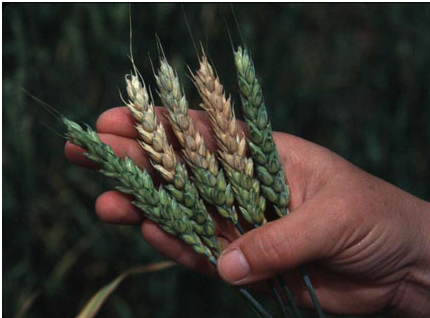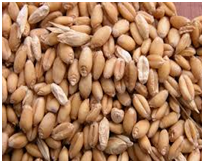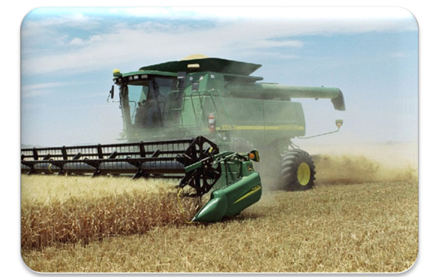Bob Kratochvil, Extension Agronomist
University of Maryland, College Park
rkratoch@umd.edu

During the past two weeks, I have had the opportunity to walk a number of small grain fields (wheat, barley, triticale) across the state. Many of those fields are infected with Fusarium head blight (FHB), aka head scab (Figure 1). I have seen fields with very low levels of infection (less than 1% of heads infected) to some that have over 50% infected heads. Thus, the reason for concern. The reason for the high number of infected fields this year is the rainy weather we have had during May. The rains coincided with flowering of the wheat, barley, and triticale. Rain splashes spores of the causal agent of the disease, F. graminearum, onto the heads allowing infection to occur. Temperatures ranging between 75 and 85°F are considered optimum but lower temperatures during periods of high humidity and moisture can also enhance infection. The over 10 inches of rain much of the state has received created ideal infection conditions.
Head scab often results in significant yield loss and grain quality reduction. Grain quality reduction is primarily the result of the mycotoxins (chemicals) that are produced by F. graminearum. These mycotoxins can be toxic for humans and animals if the concentrations exceed minimum limits. The most concerning mycotoxin is deoxynivalenol (DON), also known as vomitoxin. The Food and Drug Administration (FDA) advisory level for DON is 1 ppm for foods consumed by humans. In the case of wheat, the level is 1 ppm for the flour. Often elevators and mills will accept wheat with DON levels 1.5 – 2 ppm without penalty because they can blend infected grain with sound grain to meet the FDA advisory level. Wheat with DON levels that exceed 2 ppm can be acceptable livestock feed. Swine are the most sensitive with the recommended level of 5 ppm DON with the DON infected grain not to exceed 20% of the ration. For ruminants and poultry, grain with 10 ppm DON can be used as long as no more than 50% of the ration is composed of the infected grain.

When you harvest your grain and notice shriveled, whitish looking kernels (tombstones), there is a strong likelihood that DON is present (Figure 2). If you have head scab infected wheat or barley fields, you will want to do what you can to minimize the impact of DON that is concentrated in the shriveled tombstone kernels (Figure 2). These light-weight kernels can be separated from sound grain at harvest by increasing the combine’s fan speed so don’t be concerned that you are losing too much good grain if you see lots of tombstones behind the combine, because you are not.

If you are storing the grain do so properly to prevent further contamination. Dry newly harvested grain that is infected to 13-14 percent moisture. This will stop pathogen growth and mycotoxin production. DON is an extremely stable mycotoxin. This means that drying and properly storing grain will not reduce the DON levels, however, DON concentration will not increase in properly stored grain. Bin any infected grain you harvest separately from sound, good quality grain. If you have a cleaner, you can remove fines from the wheat before you bin it and possibly lower the DON concentration. Before you deliver your grain, I suggest you check with your elevator or mill to see if they test for DON. It will be easier to take samples to them for testing prior to delivery than to learn that your grain is rejected after you have loaded the truck and taken it to the elevator.
